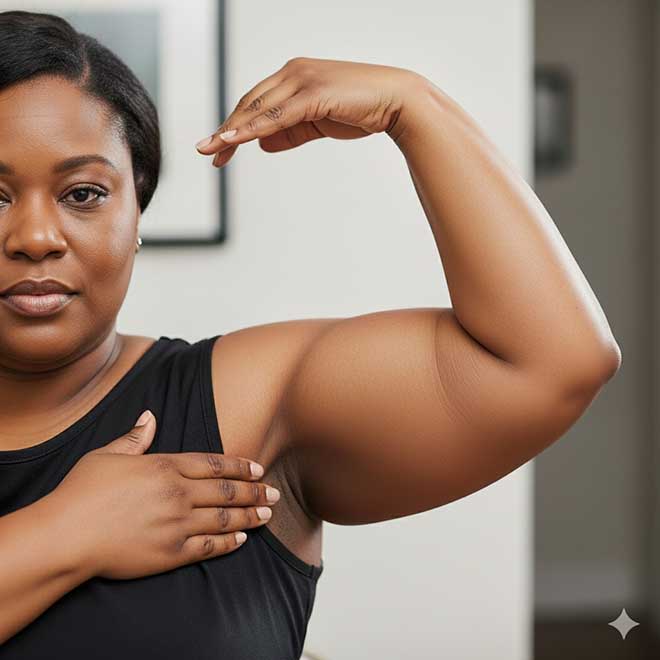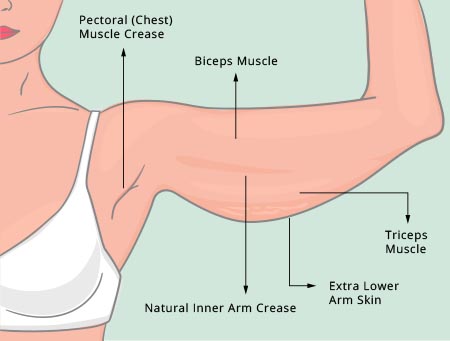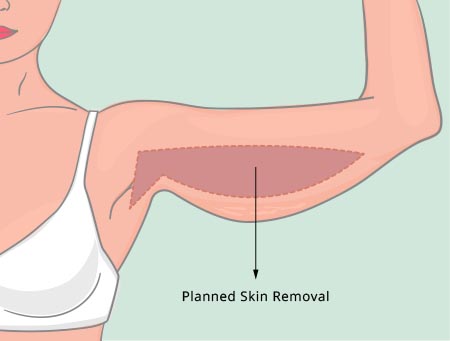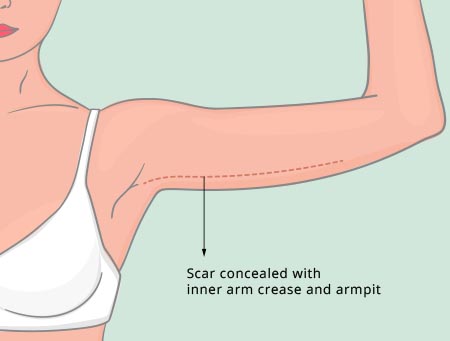
Key Takeaways
- Plus-size arm lift surgery (brachioplasty) removes excess skin and fat from the upper arms, which happens especially after losing a lot of weight.
- High BMI patients need a customized approach for smoother, safer results.
- Recovery may take longer, as they require drains, compression garments, and limited arm movement.
- Risks include delayed healing, scarring, seromas, and asymmetry, but the results improve greatly when done by an experienced surgeon.
- Choose a surgeon who specializes in high-BMI body contouring to enjoy the best results.
There’s nothing more frustrating than losing lots of weight and still seeing your saggy, heavy, and out-of-proportion arms staring back at you in the mirror. That “bat wing” look can do a number on your confidence, making you avoid short sleeves while enduring uncomfortable chafing.
Thankfully, you can get a plus-size arm lift or brachioplasty to get rid of excess skin and fat in your upper arms, especially after massive weight loss.
Schedule your Arm Lift Consultation with Dr. Masri
According to a study published by Sisti, et. al in Acta Biomedica in 2017, more and more people who’ve lost weight are looking to get a plus-size arm lift:
“Paralleling the growth of bariatric surgery, the demand for post-bariatric body-contouring surgery is increasing. Weight loss is the main cause, although not the only one, that drives patients to arm lift surgery.”
Indeed, this seems to be backed up by statistics showing that arm lift procedures increased by more than 4,000% since the year 2000:
“New statistics released by the American Society of Plastic Surgeons (ASPS) show that arm lifts in women have skyrocketed a staggering 4,378 percent in just over the last decade. It is a trend fueled, in part, by sleeveless fashions for women and more focus on strong-armed celebrities. In 2000, more than 300 women got upper arm lift procedures. Last year (2012), more than 15,000 did.”
The trend continues to increase year after year, with the number of brachioplasty surgeries breaching the 20,000 mark and increasing by 2% from 2023 to 2024 based on the 2024 ASPS Procedural Statistics Release (page 7).
But here’s the thing: not all arm lifts are created equal. While the basic approach is pretty much the same as in smaller-framed patients, the difference lies in the tissue volume involved. It adds complexity to the high BMI upper arm lift, increasing potential complications (Sisti, et. al, 2017) and making it challenging to achieve smooth contours, symmetrical arms, and hassle-free healing.
In such cases, having a highly experienced surgeon in post-weight-loss body contouring is most welcome.
Dr. Nick Masri from Miami is one of the few plastic surgeons in Florida who is double board-certified and highly experienced in post-weight loss body contouring for high BMI patients. He tailors this procedure to create smoother, tighter, and more contoured arms while prioritizing safety, symmetry, and realistic results.
But before we go in-depth into what a plus-size arm lift is, let’s first explore the reasons the standard arm lift doesn’t work for most high body mass index patients.
Why Standard Arm Lifts Often Don’t Work for Plus-Size Patients
The traditional arm lift plastic surgery was developed with smaller-framed patients in mind—that is, people with minimal fat, thin skin, great muscle tone, and normal healing patterns.
But when you have a higher BMI, you have different surgical needs. According to Dr. Masri, it’s more demanding to operate on a plus-size patient. His main considerations include:
- Skin Laxity: How much excess sagging skin is present?
- Subcutaneous Fat: How much excess tissue remains in the upper arms?
- Lifestyle: How much strain do the upper arms go through every day?
Patients typically need to get rid of more skin and fat in their flabby arms, plus they require longer recoveries.
In a 2021 study published by Samer Cabbabe in Missouri Medicine, he noted that massive weight lost patients benefit greatly from surgeons who customize their approach based on their body composition and skin quality:
“Massive weight loss (MWL) patients are more complex surgical patients than non-MWL patients. They can be successfully treated by plastic surgeons adept in their care who customize staging of the procedures as needed to yield a faster recovery, better results, and lower complications.”
Thus, having a surgeon who understands how to adapt brachioplasty techniques for fuller arms matters a lot.
The High BMI Approach to the Plus-Size Arm Lift
There’s no one-size-fits-all approach for plus-size patients. It’s best to go with a highly experienced plastic surgeon who’s spent years refining their technique to meet the arm lift needs of high BMI patients.
Most surgeons perform a staged surgical intervention for a plus-size arm lift to minimize complications. Here’s how it’s done:
Precision Liposuction First
The surgeon first performs plus-size liposuction to reduce bulk and improve contour on saggy arms before trimming away excess skin.
This is especially important among high BMI patients, as liposuction-assisted brachioplasty “preserves vascular, nervous, and lymphatic network and reduces the incidence of postoperative complications” (Di Pietro, V., et al, 2018).
And in most cases, the liposuction is performed as the first surgery in a staged approach. Patients come back for a second surgery to remove the skin.
Extended Incisions and Greater Tissue Removal
Plus-size arm lifts often require a longer incision to address skin laxity and tissue bulk. This surgical incision may extend from the elbow up to the armpit. In some cases, it even stretches toward the lateral chest wall, depending on the amount of excess skin.
A modern incision technique used is the L-brachioplasty, described by Hurwitz, D.J., et al in the Aesthetic Surgery Journal in 2010 as an L-shaped excision stretching from the elbow to the armpit, then through the armpit and along the side of the chest:
“The L-brachioplasty is an L-shaped pattern of excision with the long limb from the elbow to the axilla and the short limb extending at right angles through the axilla and along the lateral chest. The width of the excisions through the arm, axilla and chest is based on preoperative assessment through anatomical point locations followed by pinch and gathering maneuvers.”
This modification has improved the look of the resulting scar and even decreased the complications. It has also allowed the surgeon to remove lots of tissue and create smoother contours that mesh well with the rest of the body.
Tension-Minimizing Closure Techniques
Did you know that high-tension closures may cause wound breakdown in plus-size patients?
That’s why high BMI surgeons use layered closure methods to reduce incision pressure during skin tightening and improve healing. It’s the approach recommended by the NCBI StatPearls entry on brachioplasty:
“Following hemostasis, meticulous wound closure is performed in layers. The superficial fascial system layers along each wound edge are approximated by the inclusion of the floor of the brachial fascia in a 3-point closure technique. This reduces dead space and tension on the skin closure.”
It’s also beneficial for the long incisions typically associated with plus-size arm lifts, making it a curves-friendly approach.
Aside from that, they conduct follow-up consultations to ensure natural-looking results with minimal scarring.
Safe, Accredited Surgical Setting
All procedures should be done in a licensed surgical facility, where anesthesia is provided by board-certified anesthesiologists. This ensures safety and peace of mind from start to finish.
Am I a Candidate for a Plus-Size Arm Lift?
The simplest answer is this: if you’ve lost a lot of weight, leaving you with sagging, heavy skin on your upper arms that you can’t get rid of through diet or exercise, you may be a strong candidate for a plus-size arm lift.
But there are nuances to this. Here’s the criteria that Dr. Masri ticks before considering a person to be a high BMI arm lift candidate:
- Stable weight for at least 6 months (especially after bariatric surgery or GLP-1 medication use)
- Loose or hanging skin on the upper arms
- Good overall health and healing capacity
- A BMI that may still be higher than average, but well-managed with no uncontrolled comorbidities
Aside from these, you should also have realistic expectations about scarring, healing time, and results.
Take one of Dr. Masri’s plus-size arm lift patients as an example.
 “I have a specific patient in mind that I operated on years ago who had massive weight loss following a gastric bypass procedure. She lost a lot of weight and had a lot of fullness in the upper arms with excessive skin laxity and some subcutaneous fat that remained to create larger-appearing arms related to the rest of her body.
“I have a specific patient in mind that I operated on years ago who had massive weight loss following a gastric bypass procedure. She lost a lot of weight and had a lot of fullness in the upper arms with excessive skin laxity and some subcutaneous fat that remained to create larger-appearing arms related to the rest of her body.
We performed a brachioplasty procedure and the procedure was successful in that it did remove a lot of extra skin and a lot of fat density in the upper arm. However, the patient wasn’t happy because she still felt that her arms were larger than the rest of her proportionally.
Her expectations were not in line with what could actually be achieved surgically. So, I learned from that experience that it’s very important to educate patients and to really listen to patients in what they see that the procedure is going to accomplish.
In the end, when I showed this patient her pre-op and post-operative photos, she accused me of lying and showing a different patient and the only way I was able to convince her was the jewelry on her wrist was the same in the pictures. She broke down crying and couldn’t believe that the picture that I showed her of the pre-operative person was the same person that she was looking at post-operatively.
She only required a very minor scar revision, but needless to say, she was very satisfied in the end and came back for additional procedures. So, ultimately, the challenge was really trying to relate to those patients and to educate them on the expectations related to their particular needs.”
Setting realistic expectations and trusting the process are crucial not just in a high BMI arm lift, but in every procedure you’re planning to undergo. Patients who feel informed, confident, and realistic about what their surgery can achieve often end up healing better and being more satisfied with their results.
Other factors to consider include past medical history, family history, and current medications. Patients get turned away if the risks outweigh the benefits.
As a plus-size client, you should also consider how the arms fit into your overall body goals. Submit photos and discuss your goals with your surgeon to ensure they can provide a comprehensive surgical strategy based on your goals and needs.
Schedule your Arm Lift Consultation with Dr. Masri
What to Expect: Recovery Time and Results
While everyone heals at their own pace, here’s a general recovery period timeline you can expect:
Week-by-Week Recovery
Weeks 1–2
You’ll experience swelling, bruising, and arm tightness. Most patients take 1–2 weeks off from work, especially if their job involves lifting or moving their arms frequently. Surgeons also recommend using compression garments.
Weeks 3–4:
Swelling begins to improve, but you still need to wear arm compression sleeves to help reduce fluid buildup and support your arms’ new contours.
Weeks 5–6:
You can resume light activities. Your scars may still appear raised or pink, but this is normal.
After 2–3 months:
Your final results start to become noticeable as swelling subsides. Your scars also continue to mature and fade over time.
Long-Term Results
With stable weight and good scar care, results from a plus-size arm lift can be long-lasting and life-changing.
You’ll see:
- Smoother, tighter contours from shoulder to elbow
- Less chafing and skin irritation
- Increased comfort and confidence in sleeveless clothing
Maintaining a healthy lifestyle and avoiding rapid weight fluctuations are key to preserving your arm lift results long-term.
It’s tempting to compare your recovery to someone else’s or take advice from online forums, but remember that every patient’s healing is different. Be sure to follow your surgeon’s instructions to avoid potential setbacks.
Risks and Safety Considerations
As with any surgery, a plus-size arm lift comes with risks.
The literature review by Sisti, et al details the most common post-arm lift complications among high BMI patients:
“The most frequent complications are summarized in table 3. They were: hypertrophic scarring (115 patients, 10.79%) (1,16,21,23-26,30,34), seroma and lymphocele (74 patients, 6.94%) (13,21,23-26,30,35,36), delayed healing (21,24,33) and wound dehiscence (25,32,35) (61 patients, 5.72%), infection (34 patients, 3.19%), hematoma (8 patients, 0.75%).”
Let’s go through them one by one.
Delayed wound healing
You may experience slower healing because of large incisions that lead to greater skin tension. Using layered closure techniques minimizes this tension and promotes faster recovery.
Seroma or fluid accumulation
Fluid buildup under the skin may also happen among patients with more tissue volume.
Surgeons use drains to temporarily reduce the chances of this happening. Close post-op monitoring also helps.
Infection and Wound Dehiscence
Infection is always a threat, but following your surgeon’s post-operative instructions can put this at bay.
Plus, a surgeon can further lower this risk by using sterile tools, collaborating with board-certified anesthesiologists and Joint Commission-accredited hospitals, and providing personalized post-operative care and instructions.
Scarring
All arm lifts leave visible scars, but the quality of closure, post-op scar care, and individual healing factors play a major role in how they heal.
It’s also important for surgeons to explain to their patients how to manage their scars long-term to avoid hypertrophic or keloid scars—thicker, raised scars that require special treatments.
Asymmetry or contour irregularities
It takes a trained aesthetic eye to maintain balance.
That’s why working with a plastic surgeon with a track record in performing complex plus-size body surgeries is important, as this allows them to maintain your arms’ proportions with the rest of your body. They can manage these risks, protect your health, and provide results you can be proud of.
Cost of a Plus-Size Arm Lift
According to the ASPS, the average cost of a standard arm lift in the U.S. is $6,192, exclusive of other fees.
As expected, plus-size arm lift costs are usually higher than standard brachioplasties because they’re longer and more complex.
To give you an idea of what goes into the price of a high BMI arm lift, here’s a list of common fees:
- Surgeon’s fee
- General anesthesia
- Operating room and hospital fees
- Consultations and appointments
- Supplies
- Any other procedures performed at the same time (like liposuction or breast lift)
Also, high BMI surgery often requires longer hours and specialized tools for best results. This naturally increases the price, but it’s definitely a small price to pay for safety.
Look for clinics that tailor-quote their procedures to your body type and goals. It’s best if they can provide detailed and all-inclusive quotes so you’ll know exactly what to expect without any surprises. Having various financing options can also help curb costs.
Why Should You Choose Dr. Nick Masri?
When you’re choosing a surgeon for your plus-size arm lift or any other procedure like a plus size tummy tuck, credentials are obviously important—but they’re not the whole story. What you really need is someone who really understands both your body and what you’re hoping to achieve.
Dr. Nick Masri is one of the few double board-certified plastic surgeons in Florida specializing in high-BMI body lift and body contouring surgeries. Having done this for decades, he’s already helped hundreds of patients feel like themselves again after significant weight loss.
When you choose Dr. Masri, here’s what you can expect:
- A surgical plan tailored just for you
- Your safety as the top priority
- Honest and judgment-free care
- Procedures performed in a licensed, accredited surgical facility
- Clear guidance on what surgery can (and can’t) realistically do
 “Dr. Nick Masri and his staff are absolutely the best! From the minute you step into his office you will feel comfortable and at ease. Dr. Masri is one of the best plastic surgeons in the country. He takes the upmost pride in his work. You will be nothing but pleased with his work. I highly recommend Dr. Masri for any ps needs!” – Michelle Jones
“Dr. Nick Masri and his staff are absolutely the best! From the minute you step into his office you will feel comfortable and at ease. Dr. Masri is one of the best plastic surgeons in the country. He takes the upmost pride in his work. You will be nothing but pleased with his work. I highly recommend Dr. Masri for any ps needs!” – Michelle JonesSchedule Your Consultation
Your arms tell the story of everything you’ve been through. If you’re ready to write the next chapter, a plus-size arm lift might be exactly what you need to finally feel like your progress is complete.
Dr. Nick Masri gets what it’s like to be a high-BMI patient dealing with excess skin that just won’t cooperate. For him, no two patients are the same, so he listens to your concerns and doesn’t use cookie-cutter approaches, knowing your body and goals are different from everyone else’s. When you sit down with him, you’ll get a real conversation without judgment—just honest discussion about what’s possible for your specific situation.
Give us a call at (305) 343-1243 or fill out our form. It’s time to have arms that feel as good as the rest of your transformation.
Schedule your Arm Lift Consultation with Dr. Masri
Frequently Asked Questions
How long will I have drains and compression garments?
Usually 1–2 weeks, but it depends on your healing process.
Will there be scarring?
Yes, but we offer treatments to minimize visibility. Expect inner arm scars that fade over time.
How soon can I go back to work?
Most patients need 10–14 days off. But if you’re doing heavy lifting and workouts, they should be restricted for up to 6 weeks.
Can you get an arm lift if you’re overweight?
Yes, as long as you’re in good health, medically cleared, and have realistic expectations.
Will insurance pay for skin removal on arms?
Usually no, since it’s considered cosmetic. But if you have underlying medical issues that can only be solved by an arm lift, be sure to document them to get a chance to have the procedure covered by insurance.
How much does an arm lift typically cost?
Around $5,000 for standard cases. But the costs for plus-size patients are usually higher because of their more complex procedures.
What is the difference between arm lift and brachioplasty?
There’s no difference. Brachioplasty is simply the medical term for an arm lift.
Is one surgery enough?
For high BMI patients, a staged approach works better than just one surgery.
About Dr. Nidal Masri
 Dr. Nidal “Nick” Masri is a double board-certified plastic surgeon with over 25 years of experience. What sets him apart is his expertise in body contouring for high BMI and post-bariatric patients, an area where many surgeons lack the specialized knowledge needed for optimal results. Known for his straightforward, safety-first approach, Dr. Masri has become one of Florida’s most trusted names in post-weight loss plastic surgery.
Dr. Nidal “Nick” Masri is a double board-certified plastic surgeon with over 25 years of experience. What sets him apart is his expertise in body contouring for high BMI and post-bariatric patients, an area where many surgeons lack the specialized knowledge needed for optimal results. Known for his straightforward, safety-first approach, Dr. Masri has become one of Florida’s most trusted names in post-weight loss plastic surgery.
References
- American Society of Plastic Surgeons. “Arm Lift Cost.” https://www.plasticsurgery.org/cosmetic-procedures/arm-lift/cost
- American Society of Plastic Surgeons. “Plastic Surgery Trend Has Women Armed for Spring and Summer.” Press Release, 2023. https://www.plasticsurgery.org/news/press-releases/plastic-surgery-trend-has-women-armed-for-spring-and-summer
- American Society of Plastic Surgeons. 2024 Plastic Surgery Statistics Report. https://www.plasticsurgery.org/documents/news/statistics/2024/plastic-surgery-statistics-report-2024.pdf
- Gusenoff, J.A. et al. (2018). “Body Contouring After Massive Weight Loss.” Plastic and Reconstructive Surgery – Global Open, 6(9), e1950. https://www.ncbi.nlm.nih.gov/pmc/articles/PMC6140063/
- Matarasso, A., Wallach, S.G. (2010). “Brachioplasty with Concurrent Bra Rolls Excision: An Anatomic Approach and Review of 103 Consecutive Cases.” Aesthetic Surgery Journal, 30(4), 620–630. https://academic.oup.com/asj/article-abstract/30/4/620/202114
- NCBI. “Massive Weight Loss and Body Contouring.” StatPearls. Updated 2024. https://www.ncbi.nlm.nih.gov/books/NBK585115/
- Parvizi, D. et al. (2018). “Brachioplasty in Patients After Massive Weight Loss: Complications and Outcomes.” Acta Biomedica, 89(3), 418–424. https://www.ncbi.nlm.nih.gov/pmc/articles/PMC6166161/
- Zuelzer, H.B. et al. (2018). “Reoperative Brachioplasty: Outcomes and Lessons Learned.” Plastic and Reconstructive Surgery – Global Open, 6(8), e1871. https://www.ncbi.nlm.nih.gov/pmc/articles/PMC6128150/


